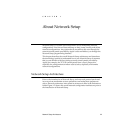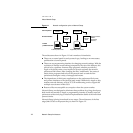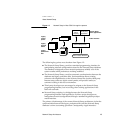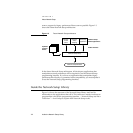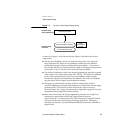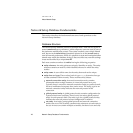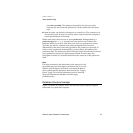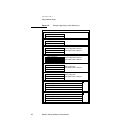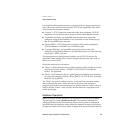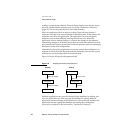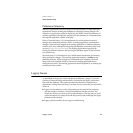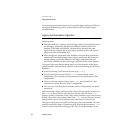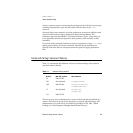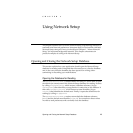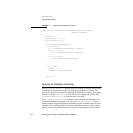
CHAPTER 1
About Network Setup
Network Setup Database Fundamentals
19
For simplicity, this example assumes a computer with two places of operation,
home and work, and two protocol stacks, TCP/IP and AppleTalk. Thus, there
are four network connection entities:
■
“AirPort,” a TCP/IP network connection entity that configures a TCP/IP
interface to use an AirPort card to access an AirPort Base Station at home.
■
“LocalTalk for Printer,” an AppleTalk network connection entity that
configures an AppleTalk interface to use LocalTalk over the Printer port, to
talk to a LocalTalk printer at home.
■
“Work/DHCP,” a TCP/IP network connection entity which configures a
TCP/IP interface to use DHCP over the Ethernet port.
■
“Company Ethernet,” an AppleTalk network connection entity that
configures an AppleTalk interface to use the Ethernet port in a zone that only
exists on the “Work” network.
The area also has two global protocol entities, one for TCP/IP and one for
AppleTalk. These settings do not need to change between home and work, so
there is only one of each.
Finally, the area has two set entities:
■
“Home,” which references the two global protocol entities and the two home
network connection entities: “AirPort” for TCP/IP and “LocalTalk for
Printer” for AppleTalk.
■
“Work,” which references the two global protocol entities but also references
two network connection entities: “Work/DHCP” for TCP/IP and “Company
Ethernet” for AppleTalk.
The “Work” set entity is marked as active, so the network connection entities
that it references are active. When the user moves from work to home, a
program (such as the Location Manager) can simply mark the “Work” entity as
inactive and the “Home” entity as active and the network configuration will
switch accordingly.
Database Operations 1
Before reading or writing preferences, an application must open the database.
The first step is to create a
database reference
. This reference identifies the
calling application to the Network Setup library and is passed to subsequent
calls that access the database. After creating the database reference, the process
diverges for readers and writers. When an application opens the default area for



